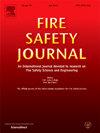On the use of surrogate gases in fire toxicity calculations
IF 3.4
3区 工程技术
Q2 ENGINEERING, CIVIL
引用次数: 0
Abstract
Engineering analyses of fire toxicity are often limited to the production, transport, and incapacitating effects of carbon monoxide and hydrogen cyanide, despite the availability of a broader range of gases in the Purser's formulation for the fractional effective dose (FED). In this work, we show how the effect of a wide set of gases can be assigned to two alternative surrogate gases, CO or CO2, combined with an effective yield of HCN. We validated the methods by measuring the yields of asphyxiant and irritant gases for five fuels, and by carrying out CFD predictions of FED using full and reduced sets of gas species. Results indicate that ignoring the full list of gases can lead to a severe underestimation of FED, with errors ranging between −12 % and −77 %. Two surrogate methods provided much more accurate predictions, with relative uncertainties between −2.2 % and +11 % for the CO + HCN -method, and −6.6 % and +1.5 % for the CO2+HCN -method. In comparison to a simulation using the full set of toxic gases, the proposed surrogate methods provide significantly simplified user input and computational savings.
关于替代气体在火灾毒性计算中的应用
火灾毒性的工程分析通常局限于一氧化碳和氰化氢的产生、运输和失能效应,尽管在主任的分数有效剂量(FED)配方中有更广泛的气体可用性。在这项工作中,我们展示了如何将一系列气体的影响分配给两种替代气体,CO或CO2,并结合HCN的有效产量。我们通过测量五种燃料的窒息性和刺激性气体的产量,并通过使用完整和减少的气体种类对FED进行CFD预测,验证了这些方法。结果表明,忽略完整的气体列表会导致对FED的严重低估,误差范围在- 12%到- 77%之间。两种替代方法提供了更准确的预测,CO +HCN -方法的相对不确定性在- 2.2%和+ 11%之间,CO2+HCN -方法的相对不确定性在- 6.6%和+ 1.5%之间。与使用全套有毒气体的模拟相比,所提出的替代方法大大简化了用户输入并节省了计算量。
本文章由计算机程序翻译,如有差异,请以英文原文为准。
求助全文
约1分钟内获得全文
求助全文
来源期刊

Fire Safety Journal
工程技术-材料科学:综合
CiteScore
5.70
自引率
9.70%
发文量
153
审稿时长
60 days
期刊介绍:
Fire Safety Journal is the leading publication dealing with all aspects of fire safety engineering. Its scope is purposefully wide, as it is deemed important to encourage papers from all sources within this multidisciplinary subject, thus providing a forum for its further development as a distinct engineering discipline. This is an essential step towards gaining a status equal to that enjoyed by the other engineering disciplines.
 求助内容:
求助内容: 应助结果提醒方式:
应助结果提醒方式:


